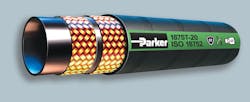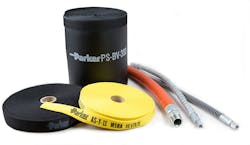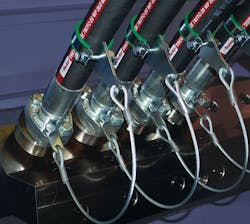The mining industry, known for its harsh and unforgiving environments, demands reliable, high-quality equipment to ensure safety and efficiency. Longwall mining, which accounts for around 50% of total underground production, has had the largest continual impact upon underground coal operations in the U.S. over the last two decades.
Longwall mining is an underground mining operation in which a large panel or block of coal spanning up to 1,500 ft across distances of two to three miles is extracted. Longwall mines are characterized by low ceilings and tight spaces in which workers must operate heavy machinery. Hydraulic-powered roof supports, also called shields, protect the working area of the mine by extending as a shearer cuts back and forth along the coal face. Once it is cut by the shearer, coal falls onto a large chain conveyor for transport to the mine. The movable hydraulic shields in longwall mines advance with the shearer throughout the mining process, enabling increased productivity as well as improved safety for miners.
Safety is imperative in the mining industry, particularly when it comes to the dangers of roof falls and lack of clean air in underground coal mines. It is vital for the equipment used in mining to be thoroughly tested to meet internationally approved MSHA standards and provide consistently reliable performance to ensure safety of operations and individuals in extreme environments.
High Performance for Mining
Because of the rigid safety and performance requirements for mining equipment, Parker Hannifin and other major hose manufacturers offer products designed specifically for mining applications. Parker’s GlobalCore 187 hose is a 1,000 psi (7 MPa) constant-working-pressure hose specifically engineered for the mining industry. ISO 18752 requires impulse testing at 133% maximum working pressure and 100°C for 200,000 cycles for standard and compact type hoses. GlobalCore 187 hose exceeds these requirements and can be used as a high-pressure return line or where other hoses may be overkill or requires a lower bending force.
Parker’s GlobalCore 187 hose meets or exceeds ISO 18752 requirements and is the only 1,000-psi constant-working-pressure hydraulic hose offered in sizes −8 through −48 (½- through 3-in. ID).
Constant-working-pressure hoses contradict traditional hydraulic hoses, in which pressure rating decreases as the inside diameter increases. For instance, if the maximum pressure requirement 1,000 psi, you could specify one hose family operating with a constant working pressure of 1,000 psi across all diameters for your hydraulic system. Converting from various product lines to a singular hose family that provides constant working pressure across sizes means a simplified selection process as well as reduced inventories, maintenance costs, and downtime.
The unified GlobalCore series of ISO 18752 hoses as the first family of 1,000 psi-rated constant-working-pressure hydraulic hose sizes from −8 through −48 (½- though 3-in. ID), and with half the minimum bend radius specified by SAE and ISO 18752. This feature reduces overall hose assembly length, promotes easier routing in the restrictive areas of underground mines, and decreases the number of bent tube fittings necessary. The tighter bend radius capability also means longer hose life in applications where machinery movement causes sharp bending of hoses.
Wide Selection for Safety
Although today’s hydraulic hose performs better than ever, a lack of maintenance, equipment abuse, or unforeseen circumstances can lead to failure of any hydraulic hose. The risk of serious injury resulting from the uncontrolled release of high pressure hydraulic fluids is an ongoing concern. Hydraulic fluid injection injuries are caused by a release of pressurized hydraulic fluid penetrating the skin. A pinhole-sized leak can travel at the same velocity as a bullet—600 ft/sec. According to research, more than 10% of mine safety incidents in the United States involve fluid power systems, with 1% of those resulting in serious injury or death.
Major hydraulic hose manufacturers offer a variety of hose cover options to resist wear, abrasion, and other environmental conditions. However, extreme conditions—such as localized heat sources or unavoidable rubbing—often call for hose sleeves, wraps, or jackets for additional protection.
Realizing this, Parker and other manufacturers have designed and engineered hoses to withstand the harsh environments of the mining industry to protect lives. The 187 hose has three different cover options (standard, ToughCover, and SuperTough cover) to increase the service life and personnel safety. A wide variety of hose sleeves, wraps, hose shields, and hose whip restraint systems are also available to protect operators, equipment, and the environment from the hazards of hydraulic hose malfunctions. You can also specify a heat-resistant sheath to protect sections of hose from excessive ambient heat and potential fire hazards.
When connections have been properly prepared and crimped, a hose should not come loose from its end fitting. Additional safety can be provided by specifying a hose whip restraint, which limits movement if a hose should be pulled away from its end fitting.
In addition to the 187 hose, Parker has an entire range of MSHA approved hoses, fittings, and equipment to service the needs of the mining industry. With a thicker, more durable outer cover to prevent impact damage from debris, Coalmaster hoses are intended for tough underground conditions. Paired with the SteckO fitting system, Parker’s Coalmaster products provide increased performance and reliability in highly abrasive environments.
Boosting Profit by Reducing Downtime
Longwall mining has shown a significant increase in production and today accounts for the largest amount of tonnage mined among underground methods. Because of this shift, improved crimping equipment that can withstand the harsh environment and keep up with increased production is essential. However, it must be cost-efficient.
Several manufacturers offer hydraulic hose crimping equipment that makes factory-quality hose assemblies quickly, easily, and cost-effectively. Parker's Parkrimp family of crimping machines crimp fittings to the proper diameter every time. These crimpers are simple to operate and built to provide years of dependable service. Parker’s family of Parkrimp models can crimp straight or bent-stem fittings from ¼- to 2-in. diameter and cover needs ranging from high-volume productivity to portable, on-site assembly.
In order for crews to efficiently operate in the cramped conditions of underground mines, equipment must be easy to use, install, and change out. Adding a global asset tagging and identification system to your mining operations would provide a fast, accurate and convenient hose assembly replacement regardless of where or when the original assembly was made. Adding an asset tag, such as Parker’s PTS label, can save users at least 15 minutes of downtime (simply stated as the time spent waiting in a store, or as the additional time spent in first removing an assembly before proceeding with the repair).
If the average cost of labor and machine downtime is calculated at the low end of $60 per hour, PTS can save the user $15 in direct productivity losses. For users with multiple, untimely failures per month, this can add up to considerable savings. Many users have documented downtime of two to three hours or more due to hydraulic hose failure, and at labor and loss productivity rates of up to $500 per hour or more. In such circumstances, asset tags can be invaluable in helping to ensure maximum machine or vehicle uptime.
Kyri McDonough is marketing services manager at Parker Hannifin’s Hose Products Div., Wickliffe, Ohio. For more information, click here www.parker.com/hpd. This article is based on material appearing in Parker’s Motion & Technology Blogs.





